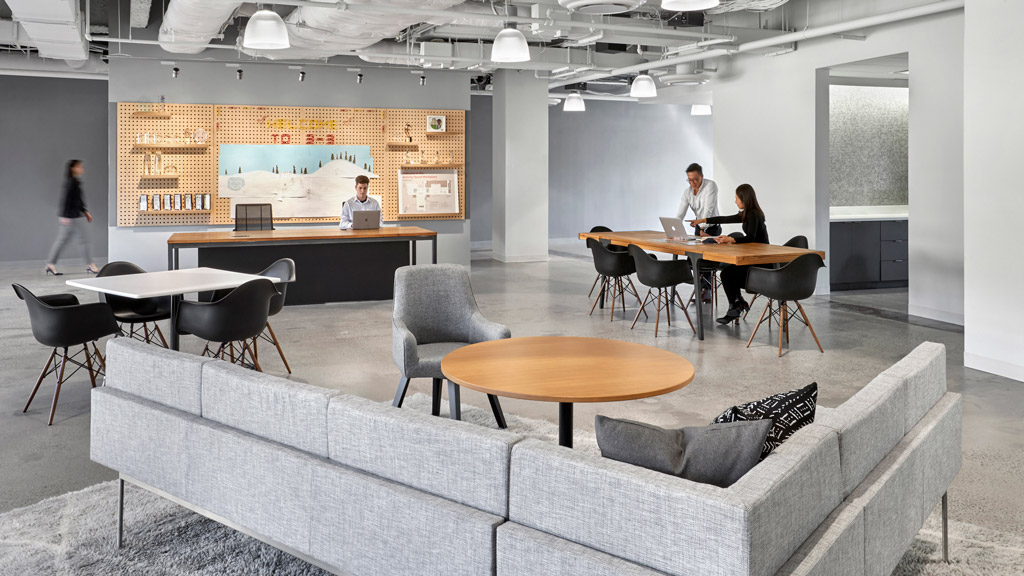Experiential Design is Changing the Rules of the Workplace
By David Craig
Following the release of our 2019 Workplace Survey — a massive cross-industry study into the impact of workplaces on knowledge workers – Gensler Morristown held an event at the end of last year to share the results. As part of the event, we facilitated a discussion with a panel of distinguished real estate executives including Yasmien Fadl from TD Bank, Joe Rossi from Verizon, and Jon Sheh from J&J.
If there was a common theme across the discussion, it was that a growing focus on experience in workplace design is changing the workplace value proposition. As a result, old expectations about what workplaces need to be successful are falling away, which leads to more flexibility in their design as well their location. But the discussion also highlighted limitations. To be valuable, companies are finding that experiences need to be designed to fit their culture and their business priorities — and generic experiences are less attractive than those created through local research and engagement.
In a wide-ranging discussion that covered everything from mobility to inclusivity in new workplaces, panelists touched on three areas where design for experience is starting to change the rules of the workplace.
The first area of change involves replacing traditional office entitlements with great experiences for all. While our 2019 research study already showed that having an assigned office isn’t a good predictor of workplace effectiveness or great experience, many people still believe otherwise, and the panelists at our Morristown event concurred that the job of changing minds never ends, no matter how many successful transformations you've gone through. However, some panelists believed that this new focus on experience has made change a little easier.
As Yasmien Fadl at TD Bank remarked, design can be used to “curate an experience,” and in doing so “we can breathe more life into the space.” In her organization, having great community spaces and relaxation spaces, for example, have been particularly valuable in supporting diverse colleague needs and have shown how important wellness is in the workplace. Work can be demanding, but a balanced, inclusive colleague experience can be positive for individual contributors and senior leaders alike. The result, as Fadl noted, is that TD Bank has seen a “cultural shift” in recognizing the benefits of experience compared to traditional entitlements.
The second area of change involves the use of amenities and variety to create a more urban sense of energy in lower cost suburbs, enticing experienced talent away from the city. Many Gen Xers and boomers, it seems, want what millennials and Gen Zers want at work: stimulation, challenge, and opportunity. For many that has meant commuting to the city, where more tends to be happening in and around offices. But the same energy can be created in the suburbs through smart design with a focus on experience. When combined with easier access and more manageable commutes, such workplaces make it easier to attract highly experienced talent in an increasingly competitive job market.
The third and final area of change that panelists touched on involves coworking – its benefits but also its limitations. As one benefit, coworking helps organizations provide space for populations too small to warrant full-service workplaces. As another, it offers temporary addresses in remote locations for client engagements. But those attractions don’t necessarily mean the workspace is ideal.
While third-party coworking providers often promote – and in some cases pioneered – transformative workplace experiences, organizations are finding that these arrangements might not fit their culture or values. Hence, some companies are creating their own versions of coworking in house – places rich in experience, variety, and flexibility. At Verizon, for example, those spaces are designed to attract outsiders and foster partnerships, but they’ve turned out to be just as successful at attracting internal adopters. Speaking about one such space in New York, Verizon's Joe Rossi observed, “It’s very much like our activity-based workplaces. As a result, we’ve been able to successfully use underutilized coworking space to support our internal teams and our growth.”
Jon Sheh at J&J noted that coworking is a trend on the minds of a lot of executives who don’t always understand the importance of locally curated experience. They ask, “Why don’t we have this?” Sheh explained. “We say, ‘We do have it, we’ve just made it our own.'” Moreover, as Sheh also noted, while third-party coworking may not be the final solution, it’s helped make everyone more focused on the value of experience and on the importance of delivering it: “My view is, in facilities, we all now have to take a retail mindset.”
That is the essence of an experience-driven workplace. The proof is no longer in the quantity or size of the workplace, or even in what it nominally does. It's in how it makes the people who use it feel and how much they enjoy being there.

